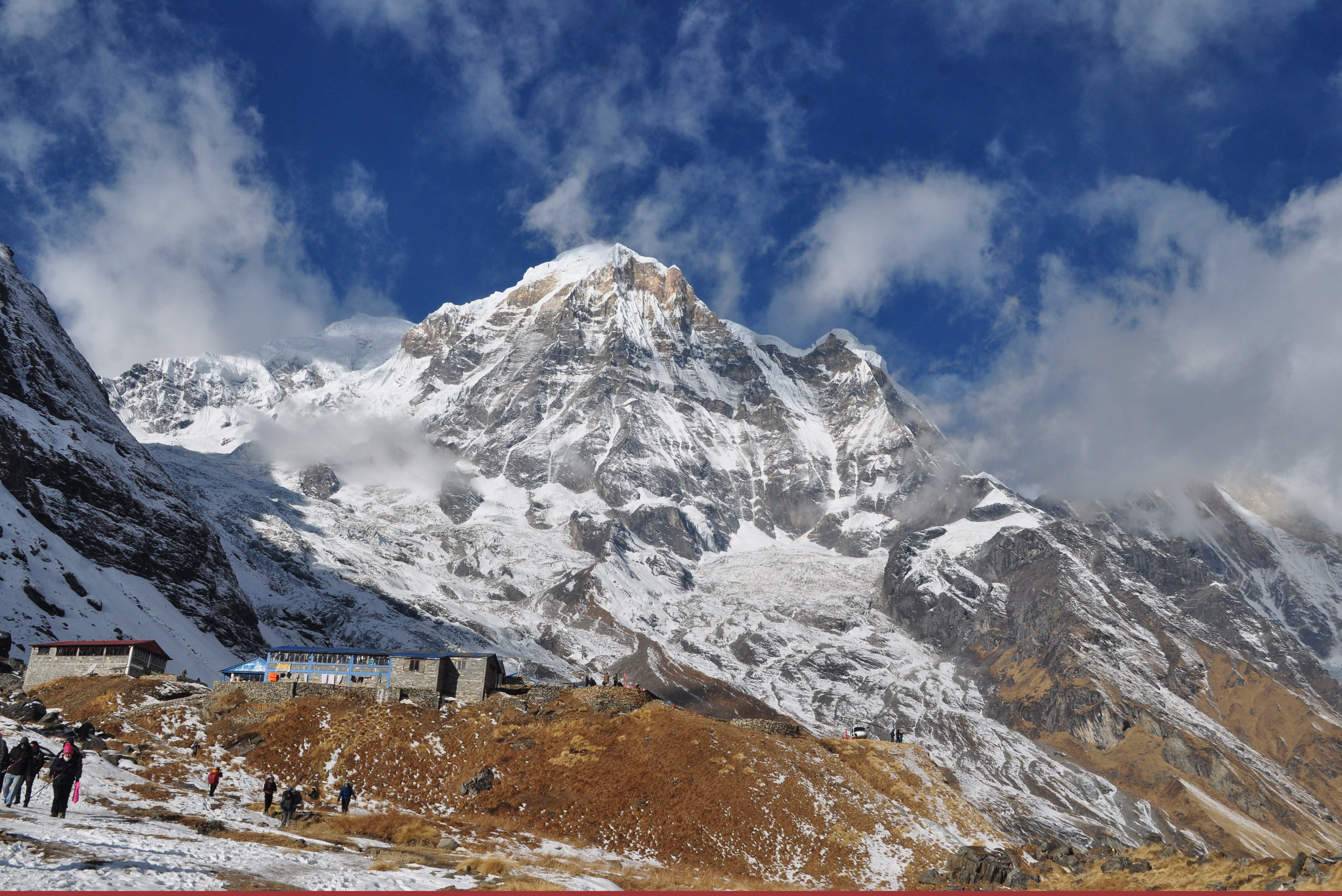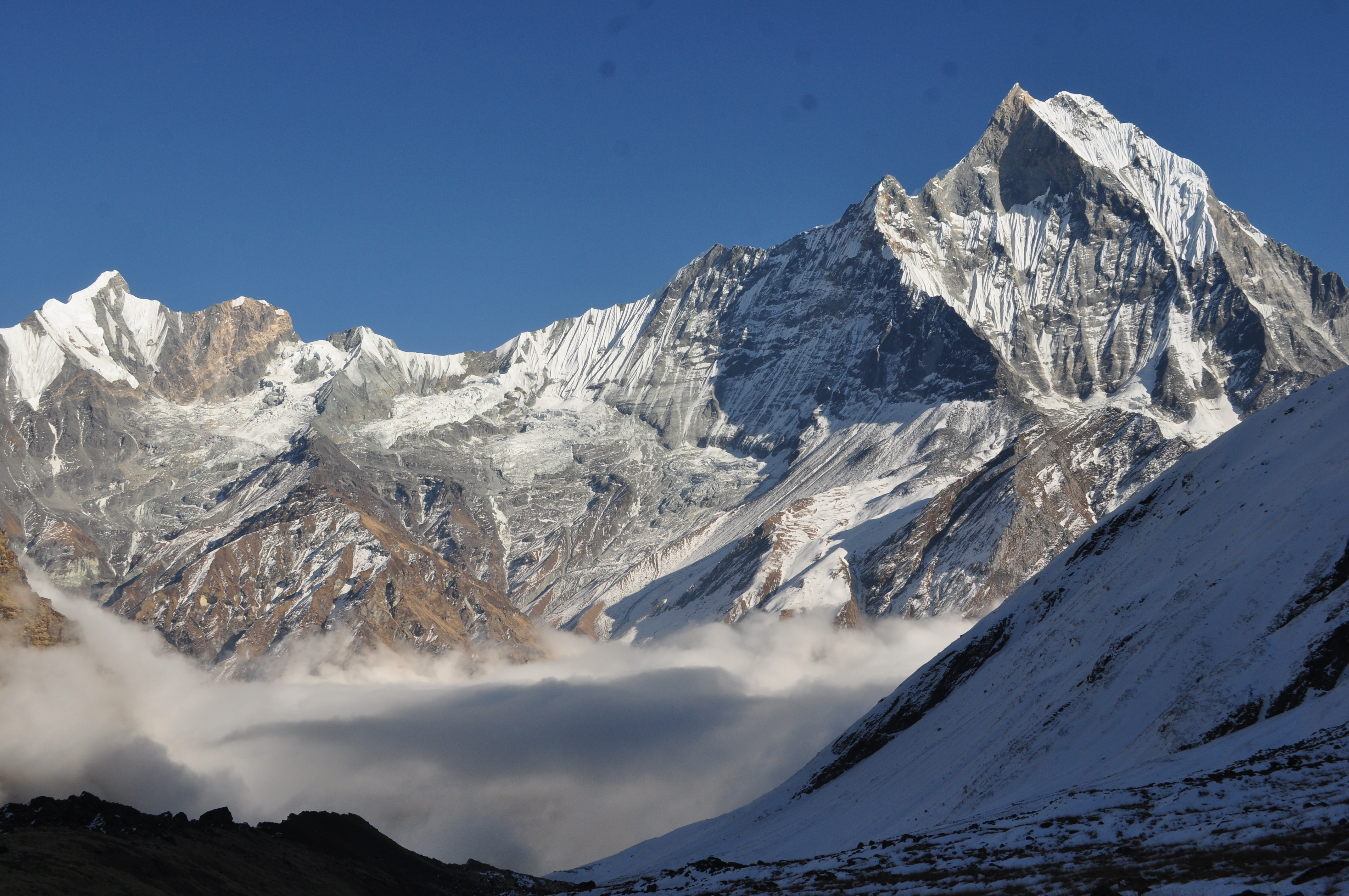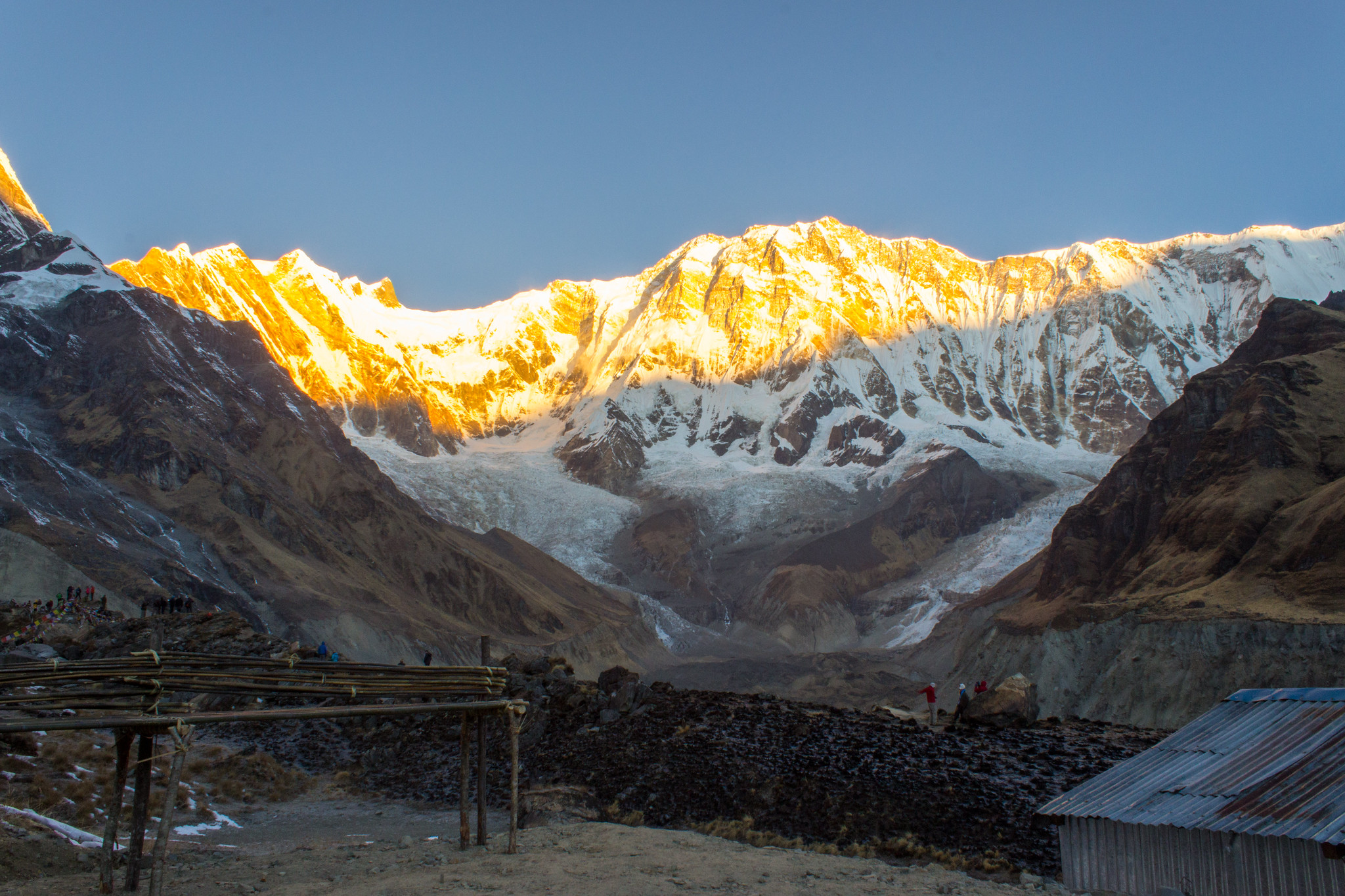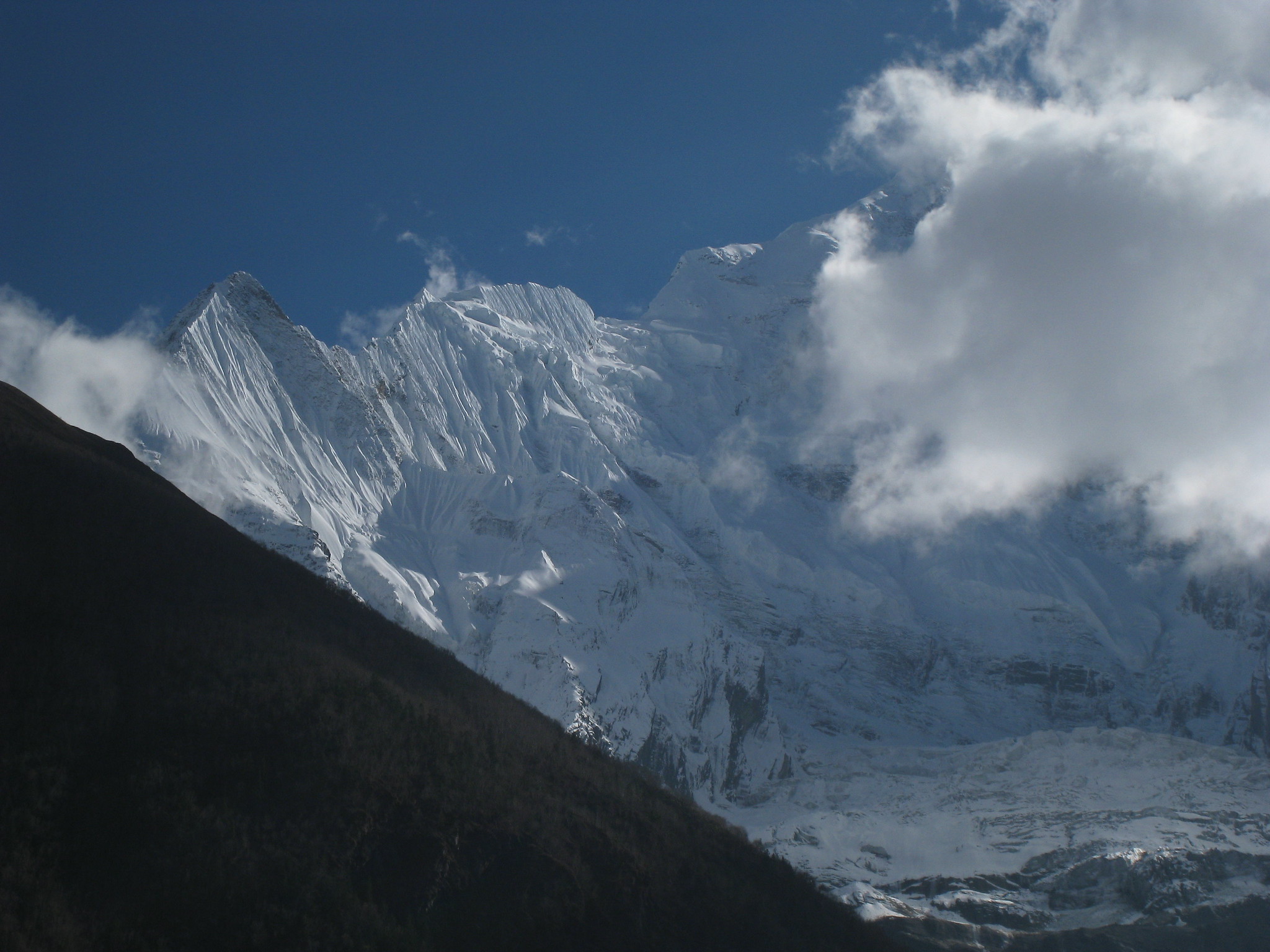Trip Highlights:
- The main highlight will be getting to view the mesmerizing Annapurna I (8091 m), Dhaulagiri (8167 m), Mt. Machhapuchhre (6997 m), Lamjung Himal (6983 m) among others.
- You will trek to the base camps of, arguably, two of the most iconic mountains: Annapurna I (8091 m) and Machhapuchhre (6697 m).
- The diverse range of flora and fauna that will accompany you on your trip is in itself a speciality of this trek.
- The trek continues through the Annapurna Conservation Area and the Annapurna Sanctuary. Thus, the biodiversity along the trekking trails will certainly amaze you.
The best time to do Annapurna Base Camp
The autumn season i.e. the time from September to November is the best time to trek anywhere in Nepal and Annapurna Base Camp Trek is no exception. Moreover, the temperature is moderate and you will be greeted with peaceful weather conditions. This is why this trekking route is the most crowded during this season.
If you want to trek in peace then winter i.e. December to February is also advisable. The view during winter is mostly clear and the roads are less crowded. Though, you need to make sure that you have enough preparations to keep yourself warm.
The time from March to May i.e. spring is also a good time for the trek since the floral beauty along the trekking trails is surreal during these months. Likewise, the wildlife also comes alive during spring.
Monsoon (June- August) is the season you need to avoid for this trek. The sky is mostly covered with clouds obstructing your view and the roads are slippery causing you safety risks. The route is also covered with leeches and mosquitoes which can cause you a foul mood on your travel.

Annapurna Base Camp Trek Itinerary
The trek route in itself is famous for being short and easy. Besides, you can enjoy your trek by passing through the river streams along the steep stone staircases and the rocky trails of the mountains. Also, you will pass through deep oak forests filled with beautiful blooming flowers of rhododendron and orchids and the traditional Gurung settlements. As such, the itinerary of the ABC Trek is as follows:
Day 01: Arrival in Kathmandu |1300m
Day 02: Kathmandu Sightseeing and Trek Preparation
Day 03: Drive to Pokhara | 820m| 6-7 Hrs/or 30 min Flight
Day 04: Drive from Pokhara to Nayapul |1.5 Hrs and Trek to Ulleri |3-4 Hrs
Day 05: Trek to Ghorepani |2860m |5-6 Hrs
Day 06: Trek to Tadapani via early morning Poonhill Hike for Sunrise
Day 07: Trek to Chhomrong |2170m |5-6 Hrs
Day 08: Trek to Himalaya |2920m |5-6 Hrs
Day 09: Trek to Annapurna Base Camp |4130m |6-7 Hrs
Day 10: Trek to Bamboo |2310m |5-6 Hrs
Day 11: Trek to Jhinu Danda/Hot Spring |1780m |5-6 Hrs
Day 12: Trek to Nayapul and drive back to Pokhara |820m |2-3 Hrs and 1.5 Hrs Drive
Day 13: Travel back to Kathmandu
Day 14: Final departure towards your destination
Trekking Permits and Costs for Annapurna Base Camp Trek
There are mainly two trekking permits required if you are planning on going along the Annapurna Base Camp trek.
The first is the Annapurna Conservation Area Project Card (ACAP card).
The permit costs about USD 2 (NRs 200) for citizens of SAARC countries and USD 20 for Non-SAARC nationals.
Another permit required for the Annapurna Base Camp trek is the Trekkers Information Management System Card (TIMS card). This card will cost you approximately USD 20 (i.e. NRs 2000) if you are a Free Individual Trekker and USD 10 (i.e. NRs 1000) if you are a Group Trekker.
You can also find more information related to trekking permits at the official website of the Department of Immigration at http://www.nepalimmigration.gov.np/page/about-trekking-permit.
You will have to bring extra cash along with you on the trip for food, accommodation, and emergency purposes should you need it in the future. Specifically, it is better to have bundles of 5, 10, 20, and 50 rupee notes which are easier to exchange for small purchases. Moreover, we also advise trekkers to carry additional cash for contingencies and emergencies.

Food, Accommodation and Their Cost During Annapurna Base Camp Trek
Most of the foods that you get at a higher altitude are especially plant-based like Dal Bhat (Rice and Lentils), Potatoes, Roti (flatbread), and cooked vegetables according to the season. In general, Ginger and Garlic are found in most food and is known to help with acclimatization. It is better to avoid meat products and heavy food while trekking.
Most of the accommodations available are small tea houses and lodges. You will be provided with warm blankets and possibly a two-bedded room. You may have to share rooms if you are visiting in peak season. Other facilities like hot water baths and Wi-Fi services can cost you some extra pennies.
The total cost during the trip varies according to the services and facilities you choose to use on the trek. Meanwhile, trekkers can also modify the travel itinerary if they want to explore other areas in the Annapurna region.
Trekking Gear or Trekking Equipment Required
You need to be prepared with comfortable trekking gear according to the weather you are trekking in. Since it is cold at higher altitudes, you need to make sure that the clothes are warm and comfortable to wear. Similarly, you will need to have waterproof gear to protect yourself from catching a cold from the unpredictable weather and sometimes unpredictable rain or snow. Cotton clothes stick less and are more comfortable for the trek.

A comprehensive list of the things required includes:
Upper Body
- Cotton T-shirts or warm long-sleeved T-shirts
- Thermals
- Fleece/Waterproof/Down Jackets
Lower Body
- Long Pants (Preferably cotton)
- Waterproof Pants
- Warm inner thermal pants
Head
- Fleece Hats
- Sun hats or scarfs
- Warm Wool Hats
- Sunglasses
Hands
- A pair of warm waterproof gloves
Feet
- Thin Inner socks
- Hiking Boots
- Hiking socks
Others
- Sleeping Bags (Optional)
- Trekking bags or Duffel Bags
- Plastic Bags (To prevent your things from getting wet)
- Trekking Poles (Optional)
- Water Bottles
- Toiletries
- Medicinal Pouch (For emergencies)
- Pain relievers and bandages
- First Aid Kit
What is Acute Mountain Sickness (AMS)?
Acute Mountain Sickness (AMS) is a condition that typically occurs at a height of 2400m above sea level because of increased pressure and a decrease in the level of oxygen. Its symptoms include dizziness, nausea, vomiting, and shortness of breath. Therefore, trekkers need to be aware of this condition if they are planning on travelling at higher altitudes.
AMS is mainly caused by quick movement to higher altitudes and overexertion. The best preventive measure is to travel slowly and let your body be more used to the higher altitudes. Also, you need to make sure not to overexert yourself on the trip.
The most prompt remedy for AMS is returning to lower altitudes and in case of severe pain in the chest emergency medical help needs to be contacted immediately. If the symptoms are not treated at an early stage then it can lead to death as well. Thus, we urge the trekkers to have travel insurance that covers medical issues and emergency evacuations as well.

Useful Tips for Annapurna Base Camp Trek
Always keep your luggage light and as compact as possible.
Keep track of the weather conditions beforehand so that you can protect yourself from natural disasters like an avalanche.
Moreover, always have an emergency plan for medical conditions like AMS.
Remember to keep a first aid kit and medical kit with you on the journey.
Be aware of the symptoms of AMS and quickly return to lower altitudes as soon as you feel the symptoms.
Finally, do not rush your journey or overexert yourself for it can lead to AMS
Conclusion
All in all, your trip to the Annapurna Base Camp is sure to be filled with unforgettable memories and thrilling experiences which will keep you on your toes at all times. Moreover, you will get to experience one of the most popular trekking routes in the world. A marvel of nature and culture, ABC Trek is a must-do for any travel fanatic anywhere in the world.







